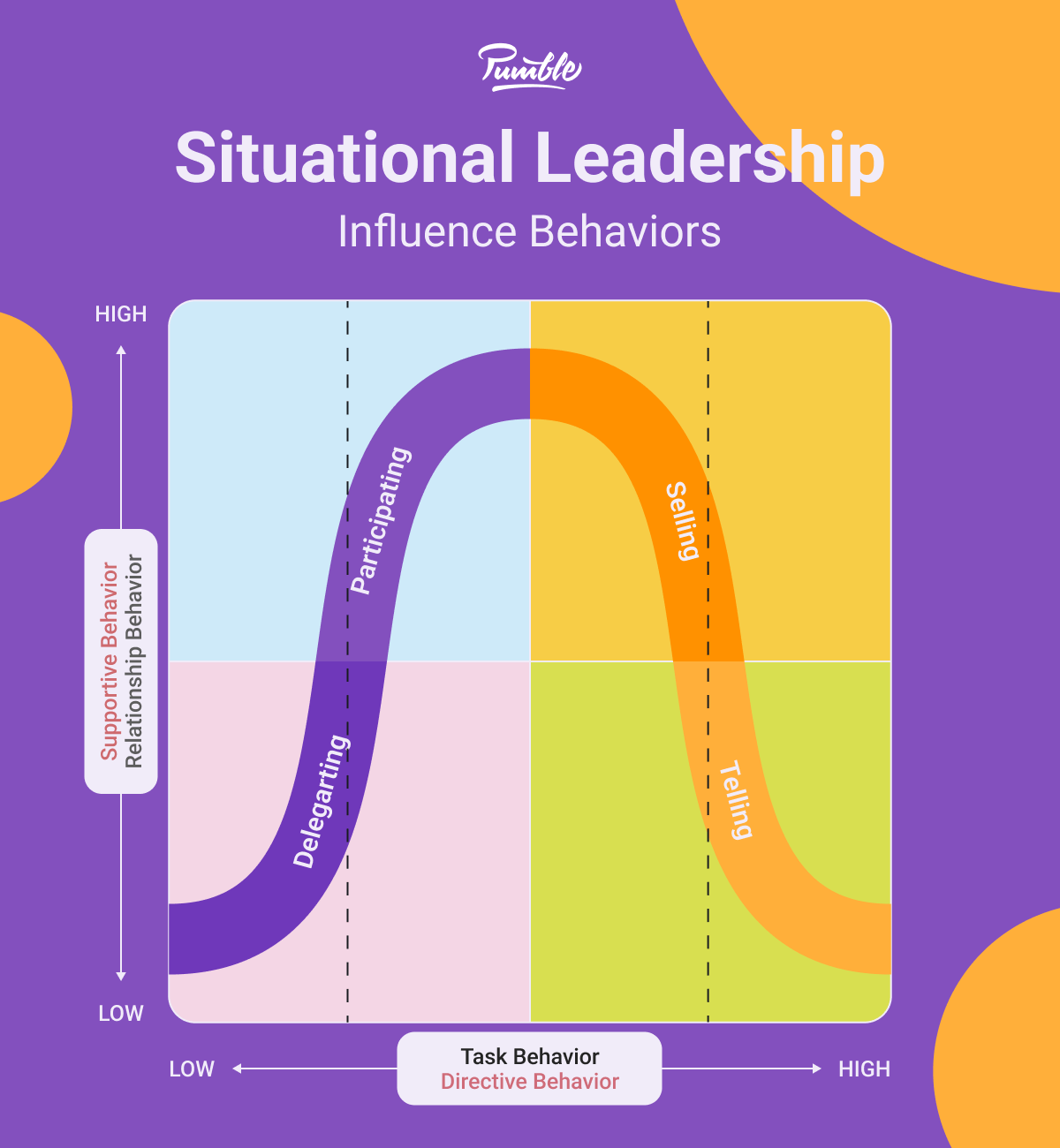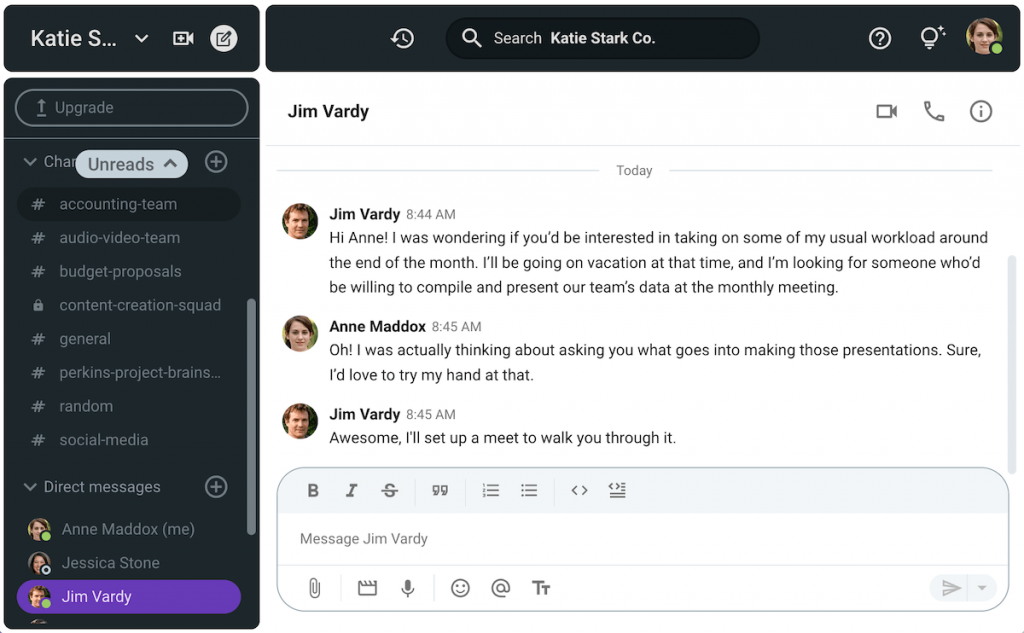Did you know that one of the most successful basketball coaches in the world, John Wooden, has attributed his great success to a situational leadership approach?
As a flexible leadership framework that is centered around team members, situational leadership is a powerful tool for leaders to boost team performance and engagement.
In this blog post, you’ll find out:
- What situational leadership implies,
- What Situational leadership theory proposes,
- What the main advantages and disadvantages of this leadership model are, and
- What activities can help you develop situational leadership skills.
So, let’s dive in!

Table of Contents
What is situational leadership?
Situational leadership is a framework that enables leaders to adapt their leadership style to current circumstances.
In other words, situational leadership style implies a flexible approach to each unique situation to meet the needs of the team or individual team members.
Therefore, the key elements of situational leadership are the following:
- The work: A task that the follower should perform.
- The follower: A team member who is assigned a specific task and has a certain level of experience and willingness to complete it.
- The leader: A person who provides a leadership style to help the follower complete a specific task.
Namely, to lead their teams successfully, leaders should adjust their style by considering variables such as:
- The team member’s experience and personality,
- The importance of the task, and
- Current external circumstances.
Therefore, situational leadership empowers leaders to deal with different situations in the workplace and bring out the best in team members.
For instance, when setting up the ground for effective work with a new team member, managers dedicate more time and energy to helping them mesh well with the team and settle into their new role.
On the other hand, when working with experienced team members, managers should have a hands-off approach and give them more authority. This way, leaders help their team grow their skills and go the extra mile.
What is a situational leader?
In connection with the situational leadership definition, we can note that a situational leader is a leader who considers:
- The characteristics and challenges of the current situation, and
- The team members’ experience level and motivation.
Therefore, a situational leader is able to perceive the conditions of each situation and adapt their approach accordingly.
Situational leadership theory
In 1969, Ken Blanchard and Paul Hersey developed the Situational Leadership Theory as a result of the belief that there isn’t a best universal leadership style.
Namely, this theory proposes that leaders should determine the performance readiness level of a team member ― which indicates their ability (task maturity) and willingness (psychological maturity) to perform a specific task.
So, once leaders diagnose performance readiness, they can adjust their leadership style accordingly.
Therefore, Hersey and Blanchard suggest a Situational leadership model that includes the 4 types of leadership styles, which are defined by two dimensions:
- Task (directive) behavior ― the extent to which the leader guides the followers and tells them what and how to do.
- Relationship (supportive) behavior ― the extent to which the leaders allow the followers to make decisions and engage in two-way communication.
So, let’s dig deeper into each type of situational leadership style.

Leadership style #1: Telling
Telling, or directing, involves a direct approach, meaning leaders tell their followers exactly what and how to do.
This leadership style describes an approach that is high on Task behavior and low on Relationship behavior.
Thus, this style is suitable for new team members who need close supervision and guidance.
In this leadership style, the communication flow is from the leader to the follower.
With that in mind, the responsibility of the leader is to ask the follower whether they have any questions, so the follower doesn’t hesitate to ask for clarification.
Leadership style #2: Selling
A leadership style with a high level of both Task and Relationship behavior is the selling or persuading style.
Leaders use this leadership style with followers who are unable but willing to perform a specific task. In other words, they are motivated but inexperienced, so leaders should encourage them to develop skills.
Thus, in this leadership style, leaders will tell less and suggest more.
Namely, leaders “sell” their ideas to team members and act as coaches. They recognize the follower’s progression and motivate them to improve their skills and grow.
For instance, selling is the right style for leading team members who are starting with new types of tasks they haven’t done before.
Leadership style #3: Participating
Participating, or sharing, is a low-task and high-relationship style, so it’s useful when the follower is experienced but unconfident or unwilling to perform the task.
In this style, leaders support and participate with the follower to ensure the task is being completed at the level required.
Most importantly, leaders focus more on the relationship with the follower rather than the task itself.
Leadership style #4: Delegating
A delegating leadership style is characterized by low levels of both Task and Relationship behavior.
Therefore, this style is useful for followers who are:
- Motivated,
- Competent, and
- Highly committed.
The leader can delegate tasks to the follower without having to provide guidance and compliments all the time.

However, it doesn’t mean that the leader should forget to give recognition and praise the followers professionally to support them.
💡 PUMBLE PRO TIP
Collaborative leadership involves a collaborative decision-making process, so everyone in a team takes responsibility for the whole. To learn more about how to take advantage of collaborative leadership and how to create a team-centric mindset, check out our blog post:
What is the most important characteristic of a situational leader?
Maybe you’ve heard the phrase: “Leaders are born, not made”, but does leadership actually come naturally or can it be learned?
Even though some people might have a natural tendency toward leadership, situational leadership is a skill that people can learn and practice.
As different conditions require different approaches, the key is to recognize the characteristics and challenges of the situation.
So, let’s see what qualities and skills are essential to successful situational leaders.
Characteristic #1: Self-awareness
A good situational leader is aware of both themselves and others. Namely, they can recognize their strengths and weaknesses, and continuously make an effort to improve their leadership skills.
Aside from that, they can accurately recognize others’ competence, confidence, and willingness to perform a specific task ― which helps them determine their performance readiness level.
Most importantly, they are well aware of the environment, which helps them adapt to each task and needs of the current circumstances.
Characteristic #2: Flexibility
As we said, situational leaders have the ability to adapt to different conditions, whether they’re related to the team members or external circumstances.
Therefore, situational leaders are flexible and ready to adjust their leadership style to ensure the best outcomes.
Characteristic #3: Active listening
In addition to flexibility, the most important skill of situational leaders is active listening.
To recognize team members’ motivation and competence for specific tasks, leaders need to practice active listening to fully understand them.
Characteristic #4: Encouragement
The responsibility of situational leaders is to create a psychologically safe work environment, so team members feel free to share their opinions and concerns and give suggestions.
This way, leaders encourage followers to participate and contribute to the overall team’s success.
Characteristic #5: Coaching skills
Situational leaders are also known for their great coaching skills.
Namely, coaching leadership style is critical for the followers who are at the selling leadership style level ― they have limited experience, but they’re motivated.
Thus, they need a leader who will be committed to their constant growth and help them acquire new knowledge and skills.
Characteristic #6: Sense of balance
In light of previous characteristics, we can note that situational leaders must have a sense of balance.
According to Sean Stewart, a Leadership Expert and Business Consultant, successful situational leaders know how to adjust their skills and experience to the current situation.

“The most important skill that a (situational) leader must have is a sense of balance. They must know how to balance the weight of their pre-existing skills and experience with the fact that every situation is unique and must be approached as such.
That requires a mix/balance of humility and an openness to feedback from the team, with confidence on the part of the leader, built upon those years of experience. So, the art of balance, the ability to stand back and assess, and a finely tuned sense of humility and confidence. It’s not an easy task to carry out and this, I think, is why some leaders fail.”
Situational leadership examples
The best way to understand situational leadership is to take a look at examples of famous situational leaders whose successes demonstrate their leadership skills.
So, let’s take a look at some great examples of situational leaders.
Example #1: Colin Powell, former US Secretary of State
Colin Powell was an American politician and United States Secretary of State who used to apply situational leadership framework.
His famous quote is:
“Leadership is solving problems. The day soldiers stop bringing you their problems is the day you have stopped leading them”.
In an interview with Forbes, Powell emphasized that he practiced situational leadership ― as everyone has a different personality, skills, and experience.
Additionally, he pointed out that he used to adjust his leadership style according to the strengths and weaknesses of people.
Example #2: Dwight D. Eisenhower, the 34th president of the United States
Dwight D. Eisenhower was the supreme allied commander during World War II, and later the 34th US president.
His strategic planning and ability to use different leadership styles in different situations made him an outstanding situational leader.
Namely, the period after the Second World War ended was unpredictable, so Eisenhower had to adjust his leadership approach to the high level of uncertainty and rapidly changing circumstances.
Furthermore, he had a great capacity for adapting to different individuals. During his presidency, he used powerful tactics such as analyzing other political leaders.
Aside from his adaptability and flexibility that allowed him to respond effectively to different situations, Eisenhower was famously known for the Eisenhower method ― task management tool that helps you prioritize tasks by urgency and importance.
This methodology divides tasks into 4 categories:
- Urgent and important: Tasks that contribute to long-term goals, and require immediate action.
- Important, but not urgent: Tasks that contribute to long-term goals, but don’t require immediate action.
- Urgent, but not important: Tasks that require immediate action, but don’t contribute significantly to goals
- Neither important nor urgent: Unnecessary tasks.
With this tool, leaders can easily prioritize tasks and avoid distractions.
Example #3: John Wooden, former basketball coach
A legendary basketball coach, John Wooden, has attributed his huge success to strong leadership skills.
Moreover, Kravis Leadership Institute presented Wooden as an outstanding situational leader.
In a Psychology Today article, Wooden is presented as a leader who focuses on sincerity and humility, and most importantly, who makes leadership about the followers, not about the leader.
His willingness to adjust his leadership style to team dynamics is reflected in his famous quote:
“When you’re through learning, you’re through.”
Example #4: Jack Stahl, former president of Coca-Cola and Revlon
Jack Stahl is an influential situational leader whose book Lessons on Leadership reveals his fundamental leadership skills.
He highlights the importance of the ability to develop people. To achieve so, it’s important to know what skills are critical for success and to be involved in the progress of each team member.
As a situational leader, he used to follow people in their development process, coach them, and adjust the approach accordingly.
Why is situational leadership critical for teams?
Our contributor, Sean Stewart, shares his opinion that all good leadership is situational.

“Each situation is different and requires fresh appraisal in terms of how to lead through the problem and achieve the result needed.
As the ancient Greek philosopher Heraclitus said, ‘You can’t step into the same river twice.’
So even if a leader is leading the very same team, into a very similar situation, it will never be exactly the same. At the absolute least, the people will be older (even if by a day) and have more experience. Their expectations might be different or more evolved.
So, having a leader who tackles each problem based on the exact situation at that time is crucial.
This is not to say that the leader ought to start with a blank slate every day and reinvent the wheel every time a new project comes along. It is to say that the leader should be alert to the fact that each project is unique.“
Therefore, each situation is unique and as such requires a unique approach.
With that in mind, we can better understand how situational leadership helps teams adapt to different circumstances and challenges.
What are the advantages of situational leadership?
All things considered, we can note that situational leadership skills are critical for thriving in an ever-changing work setting.
However, like any leadership model, situational leadership has both pros and cons.
So, first, let’s go over some advantages of the situational leadership framework.
Advantage #1: Situational leadership improves team communication
We spoke to a Leadership Expert and Keynote Speaker, Paul Bramson. He highlights that situational leadership helps leaders communicate effectively with team members:

“Effective communication is an element of almost every leadership style and certainly holds true with situational leadership. Situational leadership encourages open and effective communication between leaders and team members.
Leaders are required to assess the needs and capabilities of their team and then communicate clearly about expectations, goals, and tasks. This helps prevent misunderstandings and ensures that everyone is on the same page.”
Advantage #2: Situational leadership contributes to conflict resolution
In connection with the previous advantage, Bramson adds that situational leadership helps leaders resolve conflicts:

“Conflict resolution allows leaders to address disagreements and challenges in a way that suits the situation and the individuals involved. By adapting their approach, leaders can help in resolving conflicts more effectively and maintaining a positive team atmosphere.”
Advantage #3: Situational leadership improves team performance
As a situational leader’s approach plays to team members’ strengths, it improves their productivity and consequently overall team performance.
In other words, situational leaders adapt their leadership style to team members’ abilities and needs, which can significantly boost their performance and commitment.
Situational leaders strive to bring out the best in people, which significantly improves their motivation and commitment.
Advantage #4: Situational leadership fosters individuality
Unlike other leadership styles, situational leadership is centered around team members.
As such, it fosters individuality and workplace diversity, so situational leaders acknowledge the uniqueness of each team member and adjust their approach to meet their needs and experience.
Advantage #5: Situational leadership improves employee morale
Furthermore, situational leadership is a great employee morale booster.
When working in a supportive work environment where the leader respects their individuality and meets their needs, employees are more engaged and satisfied.
As a result, they’re more productive and less likely to look for another job.
💡 PUMBLE PRO TIP
Employee morale creates an engaged workforce and improves productivity and team communication. To learn more about how managers can boost employee morale, make sure to read our blog post:
What are the disadvantages of situational leadership?
Even though the situational leadership model stands out with great advantages, we should also mention its main downsides to keep in mind.
Disadvantages #1: Situational leadership requires a lot from leaders
Situational leadership implies frequently shifting leadership styles, which requires a lot of time and effort. As a result, the situational leadership model is complex and challenging.
Our contributor, Paul Bramson, believes that successful situational leaders have to analyze the current situation deeply and understand different leadership styles, which helps them choose the most appropriate approach:

“Situational leadership requires leaders to accurately assess the situation and the readiness of their team members, and then adapt their leadership style accordingly. This level of analysis and adjustment can be time-consuming and demanding.
Additionally, effective situational leadership demands a deep understanding of various leadership styles, as well as the ability to accurately assess team members’ skills, motivation, and the situational context. Leaders must possess strong interpersonal skills to communicate and adjust their approach appropriately.”
Disadvantage #2: Situational leadership focuses more on the short-term goals
Another disadvantage is that situational leadership is more focused on short-term goals instead of the long term since it concentrates more on immediate tasks.
However, it doesn’t mean that situational leaders should overlook the importance of creating strategies for long-term objectives.
Situational leadership activities and scenarios
The most effective way to develop situational leadership skills is to use activities and scenarios that encourage team members to share their ideas.
So, let’s take a look at some of the leadership activities that can help you master situational leadership.
Activity #1: Survey-based leadership activities and scenarios
A survey is an effective tool for collecting relevant information about:
- Team members’ motivation and needs,
- Their individual goals, and
- Strengths and weaknesses.
Therefore, leaders can create activities focusing on team members’ motivation, strengths, and weaknesses. For instance, they can organize team-building activities such as problem-solving games.
Activity #2: Group discussion activities and scenarios
Another great way to engage team members is to organize group discussions.
Aside from improving team communication, group discussions contribute to team collaboration and create a psychologically safe environment.
Namely, group discussions help leaders to better understand team members’ points of view, and encourage them to share ideas and concerns.
For example, design teams can brainstorm ideas for the company logo, so all team members can contribute and express their creativity.
Activity #3: Debating leadership activities and scenarios
Leading a debate might be challenging, but it can also connect team members and provide leaders with team members’ values and ideas.
To create a great debate scenario, it’s important to choose a relevant debate topic and make everyone engaged.
For instance, managers can create a debate about leadership, such as whether successful leaders are born or made. This way, they can understand better what team members want from their managers.
Tips on how to become a better situational leader
Now that you’re familiar with situational leadership activities and scenarios, it’s a good moment to go over some additional tips on how to become a better situational leader.
Tip #1: Familiarize yourself with various leadership styles
As we’ve established, situational leadership requires leaders to have a deep understanding of various leadership styles, so they can assess which approach is the most suitable for the current situation.
Our contributor, Paul Bramson, confirms that understanding different leadership approaches is crucial:

“Familiarize yourself with the various leadership styles, such as directive, coaching, supporting, and delegating, as proposed by situational leadership theory. Understand when each style is appropriate based on the team’s readiness and the task’s complexity.”
Tip #2: Work on your communication skills
Communication is a key factor for all leadership styles, especially for an adaptive leadership style such as the situational leadership model.
Paul Bramson highlights that situational leaders have to communicate clearly their leadership approach:

“Develop strong communication skills to:
- Convey expectations,
- Provide feedback, and
- Explain your chosen leadership approach.
Clearly explain your reasoning behind each decision to foster understanding and alignment.”
💡 PUMBLE PRO TIP
Strong communication skills are essential for all leadership styles. To learn more about how to develop and improve your leadership communication skills, make sure to read our blog post:
Tip #3: Improve your emotional intelligence
Emotional intelligence contributes to team communication and leadership skills. Additionally, it reduces chances for conflict.
According to Paul Bramson, emotional intelligence is also critical for situational leadership:

“Develop stronger emotional intelligence to understand and manage your own emotions, as well as those of your team members. This will help you respond appropriately in different situations and enhance relationships.”
Tip #4: Practice constantly
And, most importantly, becoming an effective situational leader demands a lot of practice. As we said, situational leaders learn and practice their leadership skills.
That’s why Paul Bramson emphasizes the importance of practice:

“Remember that becoming a better situational leader takes time and practice. Each team and situation are unique, so focus on continuously refining your approach based on feedback and outcomes.
Adaptability and a genuine commitment to your team’s growth and success will contribute to your effectiveness as a situational leader.”
How does situational leadership compare to other approaches?
As we’ve established, situational leadership implies a flexible approach that helps leaders thrive in different situations, leading people with different levels of motivation, commitment, and competence.
With that in mind, it’s a good moment to learn about the main differences between situational and other leadership approaches.
Comparison #1: Situational leadership vs. traditional leadership
Traditional leadership implies an authoritarian approach, so it’s typical for organizations with a strict hierarchical structure, where the leader’s authority and influence play a major role.
Furthermore, unlike situational leaders, traditional leaders rely on strict rules, rewards, and punishments to motivate their followers.
In contrast, situational leadership emphasizes the importance of the current work environment and the individuality of each team member.
| Leadership style | Situational leadership | Traditional leadership |
|---|---|---|
| Main characteristic | Importance of situational context | Hierarchical power structures |
| Leader’s behavior and traits | Adjusting conditioning behavior according to psychological and task maturity | Giving rewards and punishments, influential and authoritative behavior |
Comparison #2: Situational leadership vs. servant leadership
As a people-first leadership style, servant leadership prioritizes the growth of team members rather than business growth. Thus, both situational and servant leadership are focused on team members.
However, there are several key differences between these two, so let’s go over them.
As we’ve discussed, one of the most important skills of a successful situational leader is being aware of the current work environment.
They should assess current conditions, opportunities, and threats to ensure they’re leading their team in the most appropriate way.
On the other hand, servant leaders are extremely focused on relationships, so leaders prioritize team members’ well-being and growth. Therefore, they put team members and their relationships at the forefront of the business.
| Leadership style | Situational leadership | Servant leadership |
|---|---|---|
| Main focus | – Current work environment – Follower’s psychological and task maturity | – Relationships – Follower’s growth |
Comparison #3: Situational leadership vs. transformational leadership
Unlike traditional leadership, both situational and transformational leadership approaches prioritize adapting to the work environment and followers.
Furthermore, both leadership styles aim to improve the followers’ performance and motivation.
However, there is a main difference between these two models.
Transformational leadership emphasizes the importance of vision and long-term goals, while situational leaders focus on specific tasks and short-term goals.
Thus, a situational approach is focused on adjusting leadership style to the current situation, while transformational leaders prioritize creating a vision and inspiring the followers to achieve so.
| Leadership style | Situational leadership | Transformational leadership |
|---|---|---|
| Main objective | Short-term goals, typically task-oriented | Vision, long-term goals |
Final thoughts: Flexible approach is a key factor for situational leadership
As Ken Blanchard, a leadership expert, says:
“Leadership is not something you do to people. It’s something you do with people.”
Effective situational leaders focus on situational context, competence, and motivation of team members, which help them tailor their approach based on the current circumstances and team capabilities.
Aside from adaptability and flexibility, situational leadership demands strong communication skills and work environment awareness.
As our contributor, Paul Bramson, said, it’s all about assessing the current circumstances and the individuals involved:

“It’s important for leaders to weigh the pros and cons and determine whether situational leadership aligns with their team’s needs, their own leadership style, and the organizational context.”




